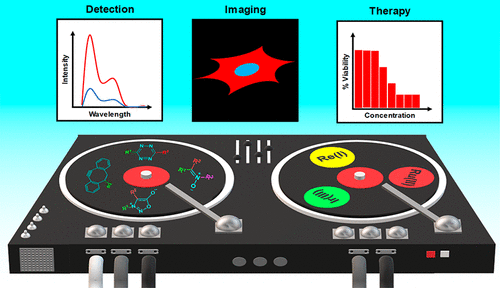当前位置:
X-MOL 学术
›
Acc. Chem. Res.
›
论文详情
Our official English website, www.x-mol.net, welcomes your
feedback! (Note: you will need to create a separate account there.)
Molecular Design of Bioorthogonal Probes and Imaging Reagents Derived from Photofunctional Transition Metal Complexes.
Accounts of Chemical Research ( IF 16.4 ) Pub Date : 2020-01-09 , DOI: 10.1021/acs.accounts.9b00416 Kenneth Kam-Wing Lo 1, 2
Accounts of Chemical Research ( IF 16.4 ) Pub Date : 2020-01-09 , DOI: 10.1021/acs.accounts.9b00416 Kenneth Kam-Wing Lo 1, 2
Affiliation

|
For more than 15 years, bioorthogonal chemistry has received increasing attention due to its successful applications in the detection and imaging of biomolecules in their native biological environments. The method typically proceeds with the incorporation of a biological substrate appended with a bioorthogonal functional group (chemical reporter), followed by the introduction of the substrate to biological systems. Biomolecules containing the substrate are then recognized by an exogenously delivered bioorthogonal probe. Despite the fact that many useful chemical reporters and bioorthogonal reactions have been developed, most of the bioorthogonal probes reported thus far are fluorescent dyes. A limitation is that stringent washing is required due to the interference caused by the background fluorescence of unreacted probes. Thus, fluorogenic probes with turn-on emission properties upon bioorthogonal labeling have been designed as an alternative strategy. These probes are highly appealing because excellent images can be obtained without the need for washing steps. Nearly all fluorogenic bioorthogonal probes designed are essentially organic dyes, their emission is limited to fluorescence, and the utilization of the probes is confined to bioimaging applications. Recently, there has been a growing interest in the bioimaging and therapeutic applications of luminescent inorganic and organometallic transition metal complexes due to their intriguing photophysical and photochemical properties, high membrane permeability, controllable cellular uptake, intracellular localization, and cytotoxicity. We anticipate that photofunctional transition metal complexes can be exploited as valuable bioorthogonal probes due to these appealing advantages. In this Account, we introduce the molecular design, photophysical and photochemical properties, and biological applications of various bioorthogonal probes and imaging reagents based on photofunctional transition metal complexes. The presence of a cationic metal center significantly enhances the bioorthogonal reactivity of the probes, yet their stability in aqueous solutions can be maintained. Interestingly, some of these metal complexes are strategically modified to display phosphorogenic properties, that is, phosphorescence turn-on upon bioorthogonal labeling reactions. Importantly, these probes not only exhibit favorable photophysical properties after bioorthogonal labeling, but also efficient photoinduced singlet oxygen (1O2) generation. This interesting bioorthogonal reaction-triggered photosensitization capability allows the modulation of 1O2 generation efficiency and contributes to the development of controllable photocytotoxic agents. The exploration of transition metal complex-based probes not only significantly widens the scope of bioorthogonal labeling but also further highlights the unique advantages of these complexes in the design of theranostic reagents. The development of these innovative reagents is expected to contribute to the basic understanding of biological processes in living systems and provide exciting opportunities for new diagnostic and therapeutic applications.
中文翻译:

光功能过渡金属配合物衍生的生物正交探针和成像试剂的分子设计。
15多年来,由于生物正交化学在其天然生物环境中对生物分子的检测和成像方面的成功应用,因此受到越来越多的关注。该方法通常通过掺入附加有生物正交官能团的生物底物(化学报告分子)进行,然后将底物引入生物系统。然后通过外源递送的生物正交探针识别含有底物的生物分子。尽管已经开发了许多有用的化学报告物和生物正交反应的事实,但是迄今为止报道的大多数生物正交探针都是荧光染料。局限性是由于未反应探针的背景荧光引起的干扰,需要严格洗涤。从而,具有生物正交标记后开启发射特性的荧光探针已被设计为替代策略。这些探头极具吸引力,因为无需清洗即可获得出色的图像。设计的几乎所有荧光生物正交探针基本上都是有机染料,它们的发射仅限于荧光,并且探针的利用仅限于生物成像应用。近来,由于发光的无机和有机金属过渡金属配合物的迷人的光物理和光化学特性,高的膜渗透性,可控制的细胞摄取,细胞内定位和细胞毒性,人们对发光的无机和有机金属过渡金属配合物的生物成像和治疗应用越来越感兴趣。我们预计,由于这些吸引人的优势,光功能过渡金属配合物可被用作有价值的生物正交探针。在此帐户中,我们介绍了基于光功能过渡金属配合物的各种生物正交探针和成像试剂的分子设计,光物理和光化学特性以及生物学应用。阳离子金属中心的存在显着增强了探针的生物正交反应性,但仍可保持其在水溶液中的稳定性。有趣的是,对这些金属配合物中的某些进行了策略性修饰以显示磷光特性,即在生物正交标记反应后开启磷光。重要的是,这些探针不仅在生物正交标记后显示出良好的光物理性质,而且还可以有效地产生光诱导的单线态氧(1O2)。这种有趣的生物正交反应触发的光敏能力可以调节1O2的产生效率,并有助于开发可控的光细胞毒性剂。对基于过渡金属配合物的探针的探索,不仅大大拓宽了生物正交标记的范围,而且还进一步突出了这些配合物在治疗诊断试剂设计中的独特优势。这些创新试剂的开发有望有助于对生命系统中生物过程的基本了解,并为新的诊断和治疗应用提供令人兴奋的机会。这种有趣的生物正交反应触发的光敏能力可以调节1O2的产生效率,并有助于开发可控的光细胞毒性剂。对基于过渡金属配合物的探针的探索,不仅大大拓宽了生物正交标记的范围,而且还进一步突出了这些配合物在治疗诊断试剂设计中的独特优势。这些创新试剂的开发有望有助于对生命系统中生物过程的基本理解,并为新的诊断和治疗应用提供令人兴奋的机会。这种有趣的生物正交反应触发的光敏能力可以调节1O2的产生效率,并有助于开发可控的光细胞毒性剂。对基于过渡金属配合物的探针的探索,不仅大大拓宽了生物正交标记的范围,而且还进一步突出了这些配合物在治疗诊断试剂设计中的独特优势。这些创新试剂的开发有望有助于对生命系统中生物过程的基本理解,并为新的诊断和治疗应用提供令人兴奋的机会。对基于过渡金属配合物的探针的探索,不仅大大拓宽了生物正交标记的范围,而且还进一步突出了这些配合物在治疗诊断试剂设计中的独特优势。这些创新试剂的开发有望有助于对生命系统中生物过程的基本理解,并为新的诊断和治疗应用提供令人兴奋的机会。对基于过渡金属配合物的探针的探索,不仅大大拓宽了生物正交标记的范围,而且还进一步突出了这些配合物在治疗诊断试剂设计中的独特优势。这些创新试剂的开发有望有助于对生命系统中生物过程的基本理解,并为新的诊断和治疗应用提供令人兴奋的机会。
更新日期:2020-01-09
中文翻译:

光功能过渡金属配合物衍生的生物正交探针和成像试剂的分子设计。
15多年来,由于生物正交化学在其天然生物环境中对生物分子的检测和成像方面的成功应用,因此受到越来越多的关注。该方法通常通过掺入附加有生物正交官能团的生物底物(化学报告分子)进行,然后将底物引入生物系统。然后通过外源递送的生物正交探针识别含有底物的生物分子。尽管已经开发了许多有用的化学报告物和生物正交反应的事实,但是迄今为止报道的大多数生物正交探针都是荧光染料。局限性是由于未反应探针的背景荧光引起的干扰,需要严格洗涤。从而,具有生物正交标记后开启发射特性的荧光探针已被设计为替代策略。这些探头极具吸引力,因为无需清洗即可获得出色的图像。设计的几乎所有荧光生物正交探针基本上都是有机染料,它们的发射仅限于荧光,并且探针的利用仅限于生物成像应用。近来,由于发光的无机和有机金属过渡金属配合物的迷人的光物理和光化学特性,高的膜渗透性,可控制的细胞摄取,细胞内定位和细胞毒性,人们对发光的无机和有机金属过渡金属配合物的生物成像和治疗应用越来越感兴趣。我们预计,由于这些吸引人的优势,光功能过渡金属配合物可被用作有价值的生物正交探针。在此帐户中,我们介绍了基于光功能过渡金属配合物的各种生物正交探针和成像试剂的分子设计,光物理和光化学特性以及生物学应用。阳离子金属中心的存在显着增强了探针的生物正交反应性,但仍可保持其在水溶液中的稳定性。有趣的是,对这些金属配合物中的某些进行了策略性修饰以显示磷光特性,即在生物正交标记反应后开启磷光。重要的是,这些探针不仅在生物正交标记后显示出良好的光物理性质,而且还可以有效地产生光诱导的单线态氧(1O2)。这种有趣的生物正交反应触发的光敏能力可以调节1O2的产生效率,并有助于开发可控的光细胞毒性剂。对基于过渡金属配合物的探针的探索,不仅大大拓宽了生物正交标记的范围,而且还进一步突出了这些配合物在治疗诊断试剂设计中的独特优势。这些创新试剂的开发有望有助于对生命系统中生物过程的基本了解,并为新的诊断和治疗应用提供令人兴奋的机会。这种有趣的生物正交反应触发的光敏能力可以调节1O2的产生效率,并有助于开发可控的光细胞毒性剂。对基于过渡金属配合物的探针的探索,不仅大大拓宽了生物正交标记的范围,而且还进一步突出了这些配合物在治疗诊断试剂设计中的独特优势。这些创新试剂的开发有望有助于对生命系统中生物过程的基本理解,并为新的诊断和治疗应用提供令人兴奋的机会。这种有趣的生物正交反应触发的光敏能力可以调节1O2的产生效率,并有助于开发可控的光细胞毒性剂。对基于过渡金属配合物的探针的探索,不仅大大拓宽了生物正交标记的范围,而且还进一步突出了这些配合物在治疗诊断试剂设计中的独特优势。这些创新试剂的开发有望有助于对生命系统中生物过程的基本理解,并为新的诊断和治疗应用提供令人兴奋的机会。对基于过渡金属配合物的探针的探索,不仅大大拓宽了生物正交标记的范围,而且还进一步突出了这些配合物在治疗诊断试剂设计中的独特优势。这些创新试剂的开发有望有助于对生命系统中生物过程的基本理解,并为新的诊断和治疗应用提供令人兴奋的机会。对基于过渡金属配合物的探针的探索,不仅大大拓宽了生物正交标记的范围,而且还进一步突出了这些配合物在治疗诊断试剂设计中的独特优势。这些创新试剂的开发有望有助于对生命系统中生物过程的基本理解,并为新的诊断和治疗应用提供令人兴奋的机会。











































 京公网安备 11010802027423号
京公网安备 11010802027423号